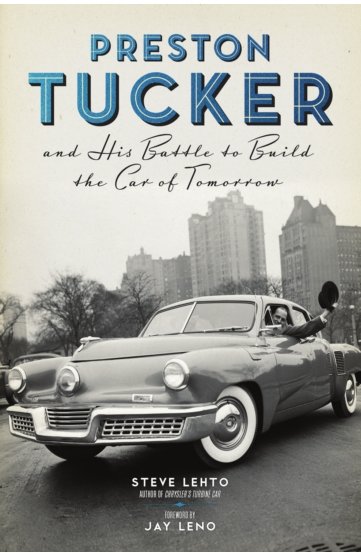 In the late 1940s, the U.S. was still recovering from the toll of World War II. The victory parties were over, and the country needed something to root for. Enter Preston Tucker, an Ypsilanti machinist turned auto salesman and his futuristic car, the Tucker 48. But Tucker and his groundbreaking streamlined car soon crashed into an onslaught of litigation and mysterious circumstances that are hotly debated to this day.
In the late 1940s, the U.S. was still recovering from the toll of World War II. The victory parties were over, and the country needed something to root for. Enter Preston Tucker, an Ypsilanti machinist turned auto salesman and his futuristic car, the Tucker 48. But Tucker and his groundbreaking streamlined car soon crashed into an onslaught of litigation and mysterious circumstances that are hotly debated to this day. The Tucker 48 was not only sleek and aerodynamic, it was also affordable. It incorporated safety features like the then-controversial seat belt and a safe zone passengers could dive into in case of a crash. Its rear engine and rear wheel drive features, while not unheard of, were rare in vehicles of the time. Perhaps its most unusual feature, however, was the single center headlight which would move right or left with the turning of the steering wheel.
“Standing still, it looked fast,” said author Steve Lehto.
While the vehicle captured the public’s imagination, it eventually succumbed to stiff resistance from the Big Three automakers and the federal government. Lehto, a Detroit area attorney and car buff, lays out the rise and fall of the Tucker 48 in his new book, “Preston Tucker and His Battle to Build the Car of Tomorrow.” Lehto is especially interested in rare experimental cars. His previous car books examine such automotive oddities as the Chrysler Turbine, the Dodge Daytona and the Plymouth Superbird.
But Lehto needed a nudge to write “Preston Tucker.” A good friend — and owner of two Tucker cars — urged him to take on the daunting project.
“Many books had been written about Tucker, but they were a long time ago and one was written by a good friend of Tucker,” Lehto said. “There was not a fully balanced biography of Tucker.”
What little the public knows about Tucker has mostly come from a 1988 film, “Tucker: the Man and His Dream,” in which Jeff Bridges plays the automaker.
“His character comes across as an optimistic, outspoken guy who could sell anything,” Lehto said.
Francis Ford Coppola, who directed the film, has a personal connection to Tucker’s legacy. Coppola’s father had invested $5,000 in Tucker’s company and lost his down payment on a Tucker car when the company went under. The director bought two Tucker cars in memory of his father.
The legend of Tucker lives on, Lehto said, because he was an underdog who took on the Big Three automakers and the federal government. Among car collectors, Tucker’s vehicle is adored. Comedian and famous auto enthusiast Jay Leno wrote the foreword to “Preston Tucker,” praising the car for its “revolutionary and futuristic” aspects.
But it’s the vehicle’s demise that’s at the core of Lehto’s book. Tucker's first problem was that he was undercapitalized. He sought out investors through a flurry of promotion, advertising and even a national tour of a Tucker concept car, but a public stock offering failed to lure enough backers.
And the worst was yet to come. Two states with close ties to the auto industry, Michigan and California, banned the sale of the stock. Then the Securities and Exchange Commission charged Tucker with fraud, charging him with taking investors’ money while never intending to bring the car to market. He was eventually acquitted, but the trial left Tucker and his company buried in debt.
“Preston Tucker was ruined when the trial was over,” Lehto writes.
Tucker tried to rebound from the failure, even teaming up with a Brazilian auto designer in hopes of designing a new sports car, but that plan never materialized. Tucker, at 53, died of lung cancer in 1956 at his home in Ypsilanti.
Only 51 Tucker 48s were produced, and 47 remain as symbols of a dream unfulfilled. Most of the vehicles have been lovingly preserved or restored, and Tucker cars consistently pull over $1 million at auctions. There are several places in Michigan to see a Tucker 48 in person. The Henry Ford Museum in Dearborn, the Gilmore Car Museum in Hickory Corners and Stahls Automotive Museum in Chesterfield all have Tucker cars.
One person who doesn’t have a Tucker is Leno. But he does own a Czechoslovakian Tatra T87, a super fast car produced prior to World War II, that was an inspiration for Tucker. In the foreward, Leno recounts how Germany banned the Tatra after the car was involved in numerous crashes. A popular joke at the time, Leno writes, was that the Czechoslovakian car had killed more Germans than the Czechoslovakian army.
Preston Tucker: His Battle to Build the Car of Tomorrow
Presented by author Steve Lehto 7 p.m., Thursday, Oct.13 FREE R. E. Olds Transportation Museum 240 Museum Drive, Lansing (517) 282-0671, lansinghistory.org
Support City Pulse - Donate Today!
Comments
No comments on this item Please log in to comment by clicking here